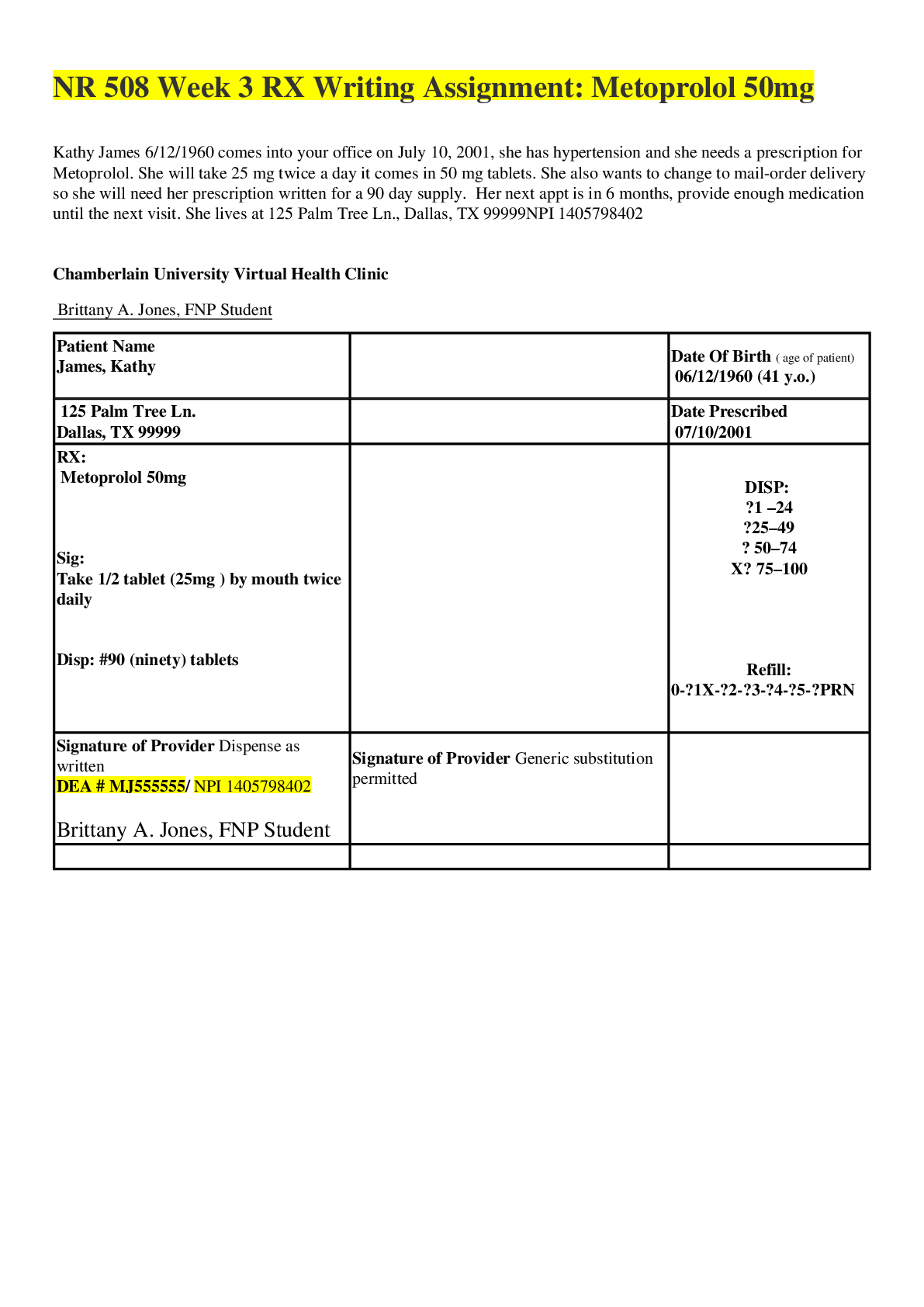Summary Chapter 4 Consciousness
Document Content and Description Below
Chapter 4 – Consciousness
I. What is Consciousness?
A. Define consciousness, waking consciousness.
● consciousness-your awareness of everything that is going on around you and inside your
...
own head at any give moment, which you use to organize your behavior, including your thoughts, sensations, and feelings.
● waking consciousness: much of people’s time is spent here. In which your thoughts, feelings, and sensations are clear and organized, and they feel alert.
B. Define altered state of consciousness. List 3 different examples of an altered state of consciousness.
● occurs when there is a shift in the quality or pattern of your mental activity. thoughts may
become fuzzy and disorganized and you may feel less alert, or your thoughts may take bizarre turns, as they so often do in dreams.
● ex: driving to school and wondering how you got there
● ex: daydreaming, being hypnotized, achieving a meditative state
II. Sleep
A. The Biology of Sleep – define biological rhythms, circadian rhythm. What is responsible for controlling your circadian rhythms?
● biological rhythms: natural cycles of activity that the body must go through
● circadian rhythm: the sleep-wake cycle. takes about a day to complete
○ controlled by the brain, specifically by an area within the hypothalamus, the tiny section of the brain that influences the glandular system.
B. The Role of the Hypothalamus – Explain how the hypothalamus regulates our sleeping patterns. Make sure to include melatonin, the suprachiasmatic nucleus. How can melatonin help jet lag?
● the release of melatonin is influenced by a structure deep within the tiny hypothalamus
in an area called the suprachiasmatic nucleus (SCN), the internal clock that tells people when to wake up and when to fall asleep.
● SCN is sensitive to changes in light. as daylight fades, the SCN tells the pineal gland to
secrete melatonin.. as it increases, the person gets sleepy. as light comes into our eyes, the SCN tells the pineal gland to stop secreting melatonin, allowing the body to awaken. (SCN also controls body temp)
● melatonin supplements are often used to treat jet lag, in which the body’s circadian rhythm has been disrupted by traveling to another time zone.
C. The Importance of Sleep and the Price of Not Sleeping – How much sleep should the average young adult get a night? Define microsleeps. What is sleep deprivation, and what are the effects of going without sleep?
● answer varies from person to person bc of age and possibly inherited sleep needs, most
young adults need 7-9 hours.
● microsleeps: brief sidesteps into sleep lasting only seconds
● sleep deprivation: loss of sleep, serious problem
○ lose more information than they gain, sleep is important for memory and ability to think well.
○ trembling hands, inattention, staring off into space, droopy eyelids, general discomfort, irritability, depression
D. Theories of Sleep
1. What is the adaptive theory of sleep?
● according to this theory, sleep is a product of evolution. proposes that animals and humans evolved diff sleep patterns to avoid being present during their predators’ normal hunting times, which typically would be at night.
● explains why people sleep when they do
2. What is the restorative theory of sleep?
● sleep is necessary to the physical health of the body
● during sleep, chemicals that were used up during the day’s activities are replenished and cellular damage is repaired.
● explains why people need to sleep
E. The Stages of Sleep – Explain the difference between REM and non-REM sleep.
● REM: relatively psychologically active type of sleep when most of a person’s dreaming takes place. voluntary movements. moves very little.
● non-REM: sleep spans from lighter stages to a much deeper, more restful kinds of sleep. person’s body is free to move around (kicking one’s partner in there sleep…)
1. Define beta waves, alpha waves, and theta waves.
● beta waves: a person who is wide awake and mentally active will show a brain-wave pattern on the electroencephalogram called beta waves. (very small and fast)
● alpha waves: as the person relaxes and gets drowsy, slightly larger and slower waves appear
● theta waves: even slower and larger waves
2. What is happening in N1: Light Sleep? Define hypnogogic images,
hypnic jerk.
● what is happening: as theta wave activity increases and alpha wave activity fades away, people are said to be entering N1 sleep/light sleep. if people are awakened at this point, they will probably not believe that they were actually asleep.
● hypnogogic images: vivid visual events or hallucinations.
● hypnic jerk: many believe it has something to do w/ the possibility that our ancestors slept in trees. relaxation of muscles as one drifts into sleep causes a “falling” sensation, at which point the body jerks awake to prevent the “fall” from the hypothetical tree.
3. What is happening in N2: Sleep Spindles?
● as people drift further into sleep, the body temp continues to drop. heart rate slows, breathing becomes more shallow and irregular, and the EEG will show the first signs of sleep spindles.
● sleep spindles: brief bursts of activity lasting only a second or two.
● theta waves will predominate, if people are awakened, they will be aware of having been asleep
4. What is happening in N3: Delta waves? Define delta waves in your
answer.
● delta waves: slowest and largest waves. these waves increase during this stage from about 20%-50% of total brain activity.
● deepest stage of sleep
● growth hormones are released from pituitary gland and reach their peak
● body is at lowest level of functioning. eventually, delta waves become dominant brain activity for this stage of sleep.
5. What is happening in R&K REM? What is sleep paralysis?
● after spending some time in N3, sleeping person will go back up through N2 and then into stage in which body temp increases to near-waking levels, eyes move rapidly under eyelids, heart beats much faster, brain waves resemble beta waves, person is still asleep but in stage known as rapid eye movement sleep (REM)/ paradoxical sleep
● sleep paralysis: voluntary muscles are paralyzed during REM sleep
6. What is the purpose of REM sleep? Define REM rebound.
● purpose: after a very physically demanding day, people tend to spend more time in NREM deep sleep than is usual. an emotionally stressful day leads to increased time in REM sleep.
● REM rebound: if deprived of REM sleep (as would occur if using sleeping pills or other depressant drugs), a person will experience greatly increased amounts of REM sleep the next night.
7. Define nightmares, REM behavior disorder.
● nightmares: bad dreams
● REM behavior disorder: rare disorder in which the brain mechanisms that normally inhibit the voluntary muscles fail, allowing the person to thrash around and even get up and act out nightmares. fairly serious condition.
8. Define night terrors. Explain the difference between nightmares and night
terrors.
● night terrors: rare disorder, a state of panic experienced while sound asleep.
● diff btw nightmares and night terrors: nightmares you remember upon waking. night terror: your body moves, you may sit up, scream, etc.
9. Define somnambulism. What might people do while in this state?
● somnambulism: real sleepwalking. least partially due to heredity.
● ex: sitting up in bed, walking around the house, looking in the fridge, getting in a car, eating. typically don’t remember the episode the next day.
10. Define insomnia. How can we avoid insomnia?
● insomnia: inability to get to sleep, stay asleep, or get a good quality of sleep.
● how to avoid? don’t consume caffeinated drinks or food that cause indigestion before bedtime taking medication for pain, and dealing with anxieties in the daytime rather than facing them at night. keep to regular schedule, dont take sleeping pills or drink alcohol, don’t try to hard to get to sleep, don’t do anything in your bed but sleep, go to bed only when you’re tired.
11. What is sleep apnea? What are the side effects of this condition, and how can it be treated?
● sleep apnea: person stops breathing for 10 secs or more. when breathing stops there will
be a silence, following by gasping sound as the person struggles to get air into their lungs. many people don’t wake up while this is happening.
● side effects: can cause heart problems, poor sleep quality
● treatment: wearing a nasal opening device, losing weight, using nasal spray, others sleep with a device that delivers continuous stream of air under mild pressure, called continuous positive airway pressure (CPAP) device. others undergo a simple surgery in which the uvula and some of the soft tissues surrounding it are removed.
12. What is narcolepsy? Define cataplexy.
● narcolepsy: “sleep seizure” the person may slip suddenly into REM sleep during the day (especially when the person experiences strong emotions). falling asleep in the wrong places and at the wrong times. makes operating a car dangerous.
● cataplexy: sudden loss of muscle tone. may cause injuries if the person is standing when the attack occurs.
III. Dreams
A. Why do people dream?
1. Explain Freud’s ideas of why we dream. Define manifest and latent
content.
● he believed that conflicts, events, and desires of the past would be represented in symbolic form in people’s dreams
● believed them to be a wish fulfillment
● manifest content: actual dream itself
● latent content: true meaning of a dream is hidden, only expressed in symbols
○ water could symbolize birth
○ bathtub could symbolize mother’s womb
2. Explain the activation-synthesis hypothesis. Explain the
activation-information-mode model, and how it differs from the activation-synthesis hypothesis.
● activation-synthesis hypothesis: premise that states that dreams are created by the higher centers of the cortex to explain the activation by the brain stem of cortical cells during REM sleep periods
● activation-information-mode model: revised version of the activation-synthesis explanation of dreams in which information that is accessed during waking hours can have an influence on the synthesis of dreams
IV. The Effects of Hypnosis – Define hypnosis
● hypnosis: state of consciousness in which the person is especially susceptible to suggestion
A. What Can Hypnosis Really Do?
1. Can people be hypnotized against their will? Define the basic suggestion
effect.
● people cannot be hypnotized against their free will
● basic suggestion effect: tendency to act as though their behavior is automatic and out of their control
○ gives people an excuse to do things they might not otherwise do because the burden of responsibility for their actions falls on the hypnotist
B. Theories of Hypnosis
1. Explain the idea of hypnosis as dissociation.
● Ernest Hilgard believed that hypnosis worked only on the immediate conscious mind of a person, while a part of that person’s mind remained aware of all that was going on.
● hilgard believes that there is a hidden part of the mind that is very much aware of the hypnotic subject’s activities and sensations, even though the “hypnotized” part of the mind is blissfully unaware of these same things.
2. Explain the social-cognitive perspective on hypnosis.
● the social-cognitive theory of hypnosis assumes that people who are hypnotized are not in an altered state but are merely playing the role expected of them in the situation.
● they might believe that they are hypnotized, but in fact it is all a very good performance, so good that even the “participants” are unaware that they are role playing
V. The Influence of Psychoactive Drugs – Define psychoactive drugs.
● psychoactive drugs: chemical substances that alter thinking, perception, and memory
A. Dependence
1. Define physical dependence, drug tolerance, withdrawal. Explain how a drug can be a negative reinforcer. What brain changes occur with dependence?
● physical dependence: condition occurring when a person’s body becomes unable to function normally without a particular drug
● drug tolerance: decrease of response to a drug over repeated uses, leading to the need for higher doses of drug to achieve the same effect
● withdrawal: physical symptoms that can include nausea, pain, tremors, crankiness, and high blood pressure, resulting from a lack of an addictive drug in the body systems
● explain how a drug can be a negative reinforcer:
○ many users will take more of the drug to alleviate the symptoms of withdrawal, which makes it worse
○ negative reinforcement: tendency to continue a behavior that leads to the removal of or escape from unpleasant circumstances or sensations
■ very powerful motivating factor, and scores of drug-dependent users exist as living proof of that power
● brain changes that occur with dependence are
○ reduced number of receptors
○ drugs that lead to dependence cause the release of dopamine in a part of the brain called the mesolimbic pathway, a neural track that begins in the midbrain area (just above the pons) and connects to limbic system structures, including the amygdala and the hippocampus, and continues to the middle of the prefrontal cortex
○ when a drug enters the body, it goes quickly to this area, known as the brain’s “reward pathway” causing a release of dopamine by decreasing the number of synaptic receptors for dopamine.
2. Define psychological dependence, stimulants, depressants, and hallucinogenics.
● psychological dependence: feeling that a drug is needed to continue a feeling of emotional or psychological well-being
● stimulants: drugs that increase the functioning of the nervous system
● depressants: drugs that decrease the functioning of the nervous system
● hallucinogenics: drugs including hallucinogens and marijuana that produce hallucinations or increased feelings of relaxation and intoxication
B. Stimulants
1. Define amphetamines. How do amphetamines affect the body/behavior?
● amphetamines: stimulants that are synthesized in laboratories rather than being found in nature
● affects: cause the sympathetic nervous system to go into overdrive
○ cause people to burn up whatever energy reserves they do have
○ depresses the appetite, another function of sympathetic division
○ when the energy reserves are exhausted or drug wears off, you crash and the tendency is to take more pills to get back “up”
○ nausea, vomiting, high blood pressure, and strokes are possible,--state called amphetamine psychosis--causes addicts to become delusional and paranoid
■ they think people are out to get them
■ violence is a likely outcome against self and others
2. Define cocaine. How does cocaine affect the body/behavior?
● cocaine: a natural drug derived from the leaves of the coca plant
● affects:
○ produces feelings of euphora, energy, power, and pleasure
○ deadens pains and suppresses appetite
○ 1st time using it: some people have convulsions and may even die
○ can have devastating effects on children born to mothers who use cocaine and has been associated with increased risk of learning disabilities, delayed language development, and an inability to cope adequately with stress, among other symptoms
○ users experience severe mood swing into depression (crash) followed by extreme tiredness, nervousness, and inability to feel pleasure, and paranoia
3. Define nicotine. How does nicotine affect the body/behavior? Why is it so hard to quit?
● nicotine: active ingredient in tobacco
● affects:
○ produces a slight rush or sense or arousal as it raises blood pressure and accelerates the heart, as well as providing a rush of sugar into the bloodstream by stimulating the release of adrenaline in addition to raising dopamine levels in the brain’s reward pathway.
○ relaxing effect on most people and seems to reduce stress
○ first-time smokers often experience nausea
● hard to quit because
○ powerfully addictive
■ more powerful than heroin or alcohol
○ physical withdrawal symptoms can be as bad as those resulting from alcohol, cocaine, or heroin abuse
4. Define caffeine. How does caffeine affect the body/behavior?
● caffeine: mild stimulant found in coffee, tea, and several other plant-based substances
● affects:
○ maintains alertness
○ can increase effectiveness of some pain relievers
○ keeps people awake
C. Depressants
1. Explain the difference between major and minor tranquilizers.
● major tranquilizers: drugs that have a strong depressant effect (sleeping pills) barbiturates are drugs that have a sedative (sleep-inducing effect)
● minor tranquilizers: drugs having a relatively mild depressant effect
○ include the benzodiazepines. drugs used to lower anxiety and reduce stress
2. Define alcohol and binge drinking. What are the danger signs associated with alcohol? What does alcohol do to your brain?
● alcohol: chemical resulting from fermentation or distillation of various kinds of vegetable
manner
○ alcohol is a depressant that gives the illusion of stimulation, because the very first thing alcohol depresses is a person’s natural inhibitions, or the “don’ts” of behavior
● binge drinking: drinking four or five drinks within a limited amount of time, such as “happy hour”
● danger signs:
○ drunkenness is a major sign of alcoholism
○ feeling guilty about drinking
○ drinking alone
○ being sensitive about how much one drinks when others mention it
○ drinking so much that one does and say things one later regrets
○ drinking enough to have blackouts or memory loss
○ drinking too fast
○ lying about drinking
○ drinking enough to pass out
● what does alcohol do to your brain:
○ alcohol indirectly stimulates the release of a neurotransmitter called GABA, the brain’s major depressant. GABA slows down or stops neural activity. As more GABA is released, the brain’s functioning becomes more and more inhibited, depressed, or slowed down. the areas of that brain that are first affected are the areas that control social inhibitions. as the effects continue, motor skills, reaction time and speech are all affected.
D. Narcotics – define narcotics.
● narcotics: a class of opium-related drugs that suppresses the sensation of pain by binding to and stimulating the nervous system’s natural receptor sites for endorphins
1. Define opium. How does opium affect the body?
● opium: substance derived from the opium poppy from which all narcotic drugs are derived
● affects: pain-relieving and euphoria inducing properties
○ highly addictive, it mimics the effects of endorphins, the nervous system’s natural painkillers. nervous system slows or stops its production of endorphins. when the
drug wears off, there is no protection against any kind of pain, causing the severe symptoms of withdrawal associated with these drugs
2. Define morphine, heroin.
● morphine: narcotic drug derived from opium, used to treat severe pain
○ created by dissolving opium in an acid and then neutralizing the acid with ammonia. used to control severe pain.
● heroin: narcotic drug derived from opium that is extremely addictive
E. Hallucinogens
● cause the brain to alter its interpretation of sensations
● can produce sensory distortions very similar to synesthesia in which sensations cross over each other--colors have sound, sounds have smell, etc.
1. Define LSD. How does LSD affect the body/behavior?
● LSD: (lysergic acid diethylamide) powerful synthetic hallucinogen
○ synthesized from a grain fungus called ergot
● affects:
○ high feeling
○ expands consciousness or awareness or world around them
○ colors seem more intense, sounds more beautiful, etc.
○ “bad trips” are quite common
○ effect it has on a person’s ability to perceive reality
○ real dangers and hazards in the world may go unnoticed by a person lost in an LSD fantasy, and people under the influence of this drug may make poor decisions such as trying to drive while high
2. Define PCP. How does PCP affect the body/behavior?
● PCP: synthesized drug now used as an animal tranquilizer that can cause stimulant, depressant, narcotic, or hallucinogenic effects
● affects:
○ depending on the dosage, it can be a hallucinogen, stimulant, depressant, or an analgesic (painkilling drug)
○ can experience hallucinations, distorted sensations, and very unpleasant effects
○ lead to acts of violence against others or suicide
○ may physically injure themselves unintentíonally because PCP causes them to feel no warning signal of pain
3. Define Ecstasy, stimulatory hallucinogenics. How does Ecstasy affect the body/behavior?
● ecstasy: (MDMA,X) designer drug that can have both stimulant and hallucinatory effects
○ techbically a amphetamine
● stimulatory hallucinogenics: drugs that produce a mixture of psychomotor stimulant and hallucinogenic effects
● ecstasy affects:
○ can be deadly when misused
○ causes the release of large amounts of serotonin and also blocks the reuptake of this neurotransmitter
○ user feels euphoria, energized, and may feel increased emotional warmth towards others
○ may damage the serotonin receptors, which could lead to depression
○ severe dehydration, raised body temperature, which can lead to excessive intake of liquids--with possible fatal results
4. Define marijuana. How does marijuana affect the body/behavior?
● marijuana: mild hallucinogen derived from the leaves and flowers of a particular type of hemp plant called cannabis sativa
● affects:
○ a feeling of well-being, mild intoxication, and mild sensory distortions or hallucinations
○ higher doses can lead to hallucinations, and paranoia
○ can create a powerful psychological dependency
○ affects reaction time and perceptions of surroundings
○ reduces ability to make the split-second decisions that driving a car or other equipment requires
○ information processing, attention, and memory are likely to be impaired
○ stimulates the appetite
○ increased risk for psychotic symptoms and disorders later in life for adolescents who are regular and heavier users
○ chronic nonmedical
■ increased risk of motor vehicle crashes, chronic bronchitis, or other lung problems, and cardiovascular disease
○ in adolescents who are regular users
■ psychological development, educational attainment, and mental health can be negatively impacted
[Show More]
Last updated: 3 years ago
Preview 1 out of 11 pages
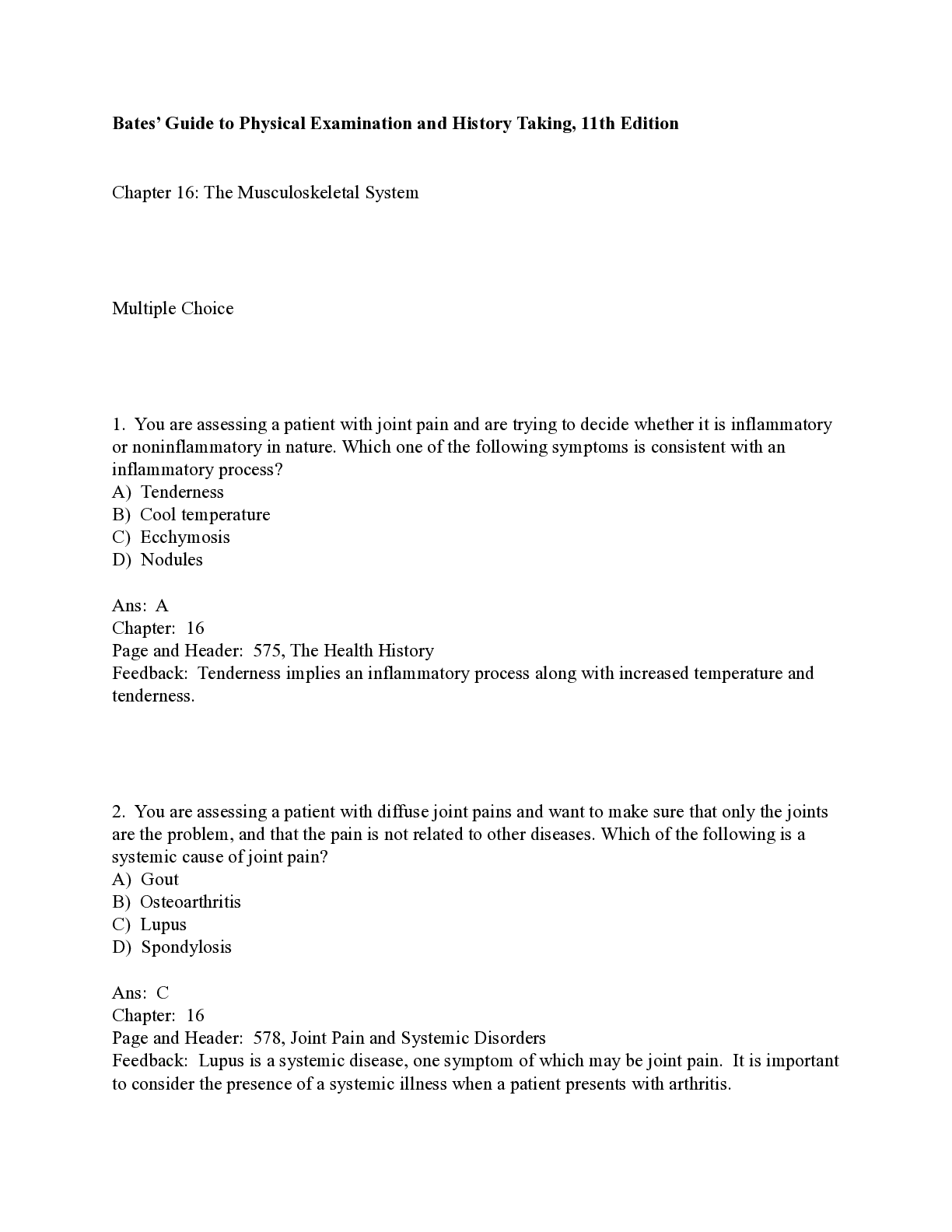

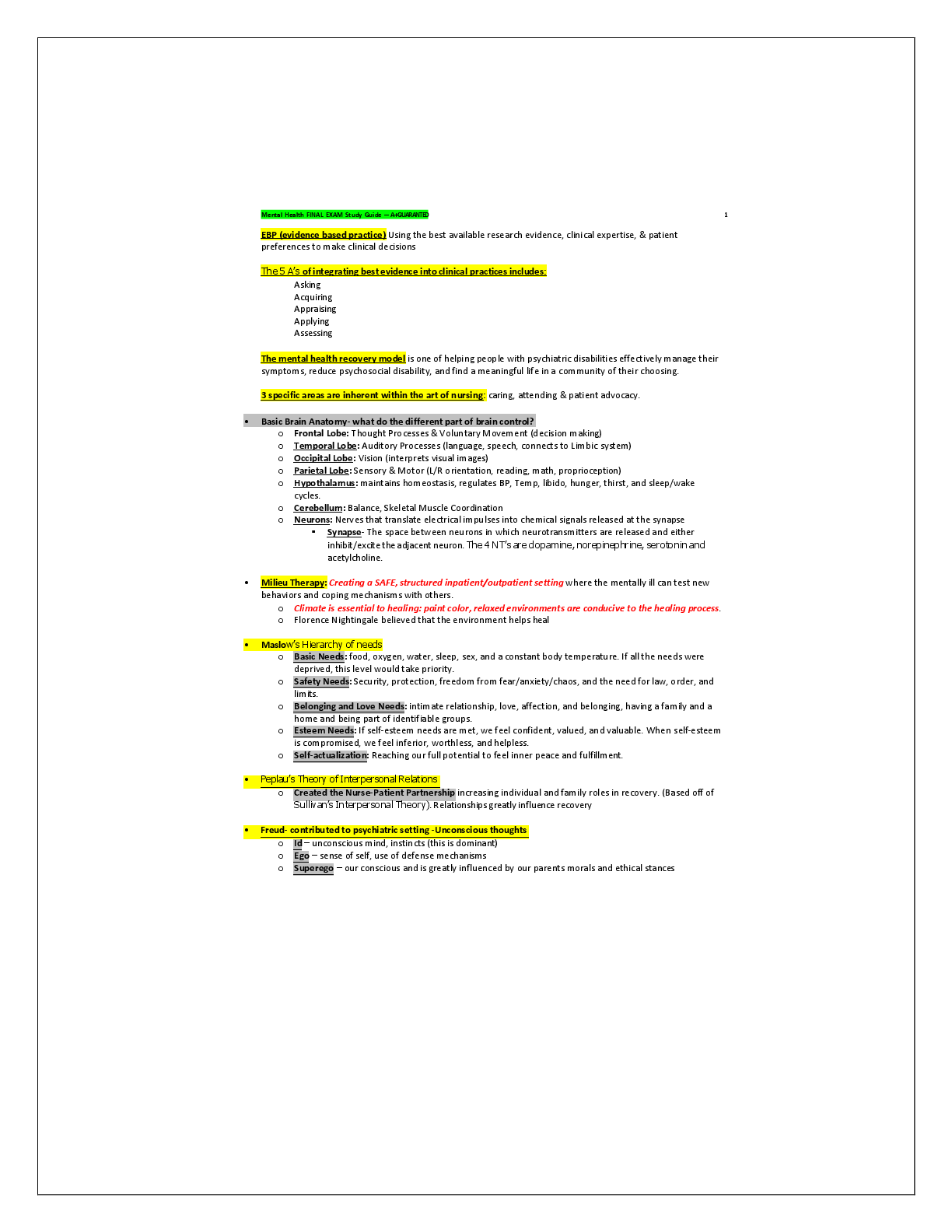
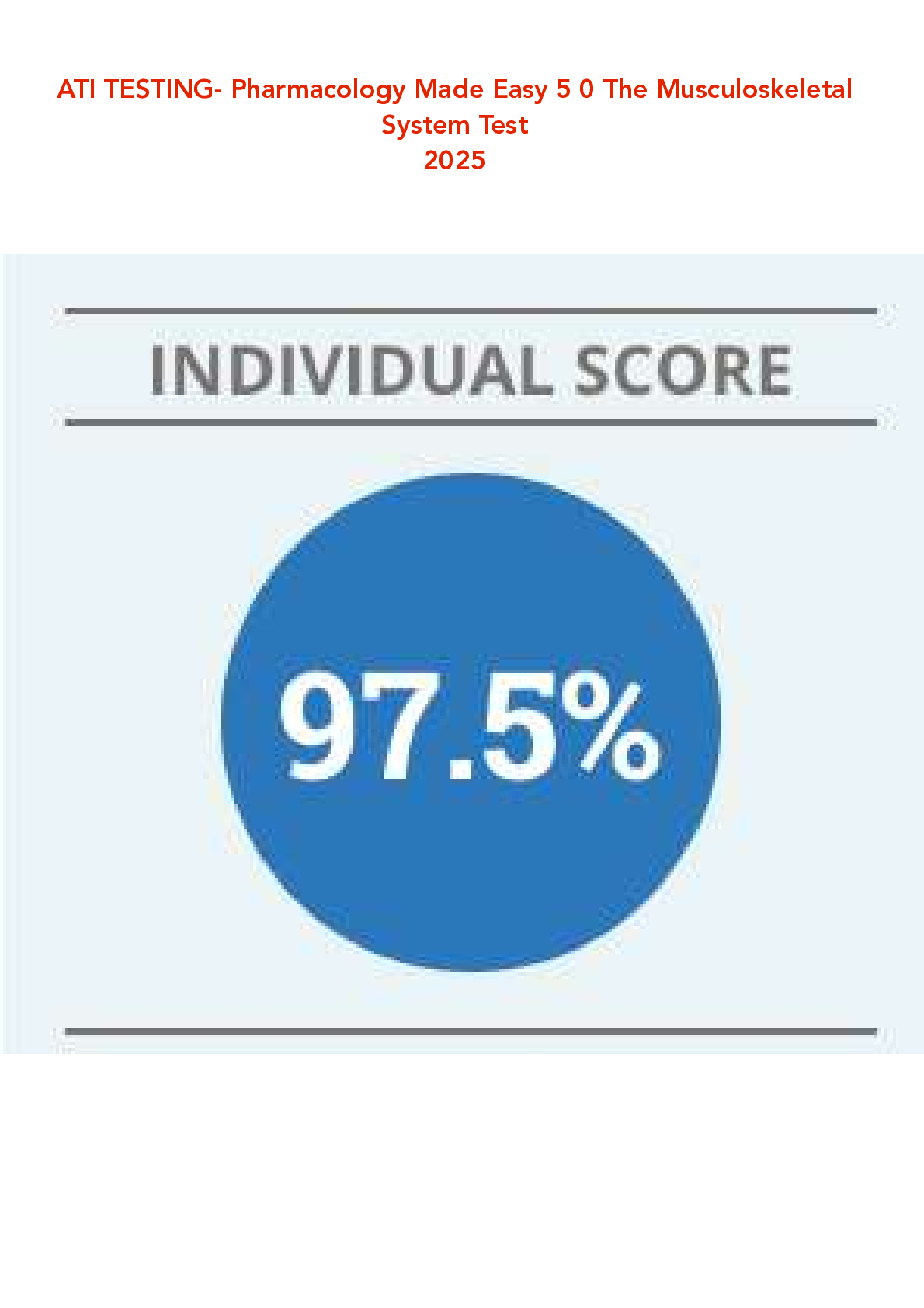


 (1).png)



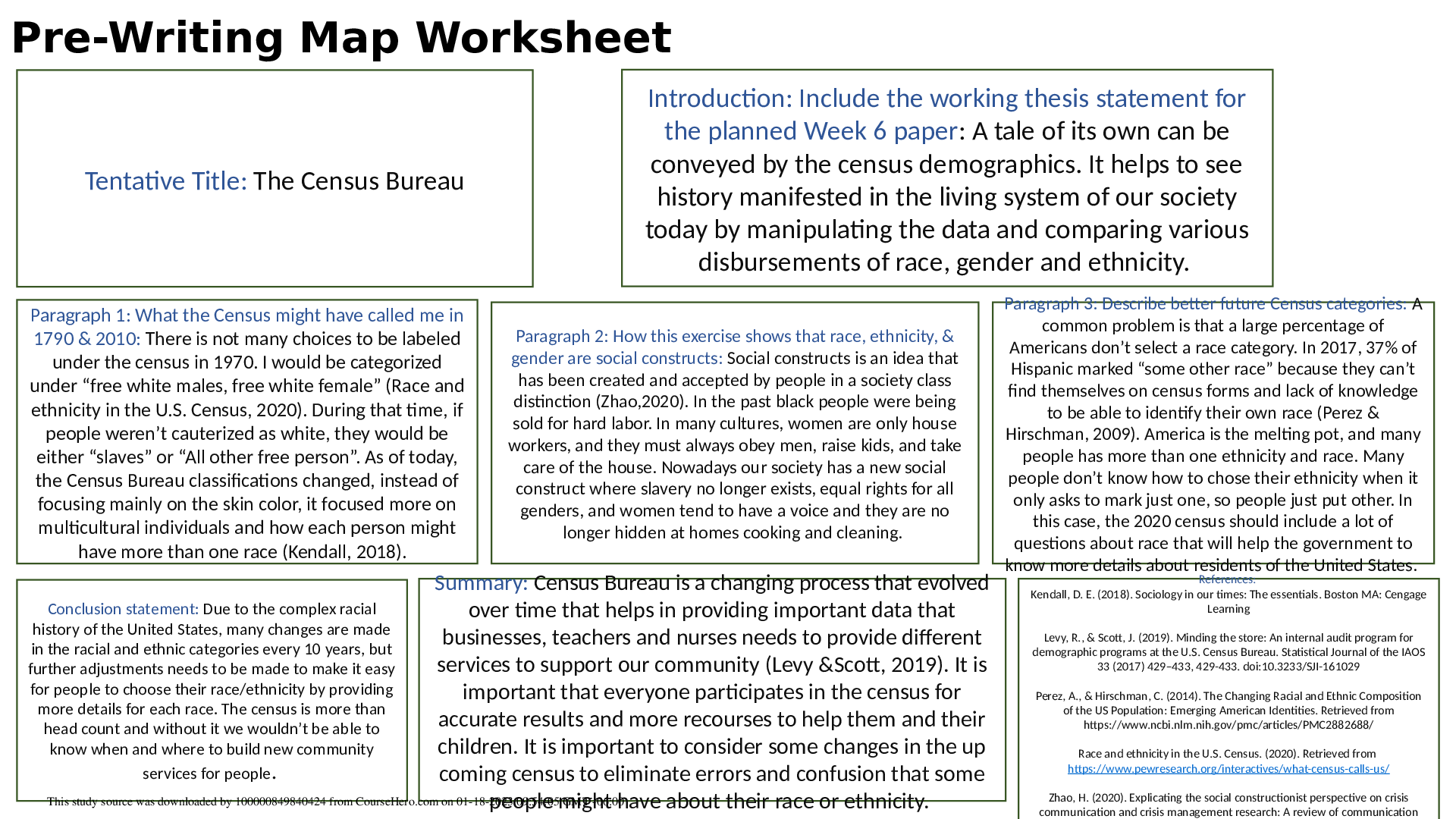
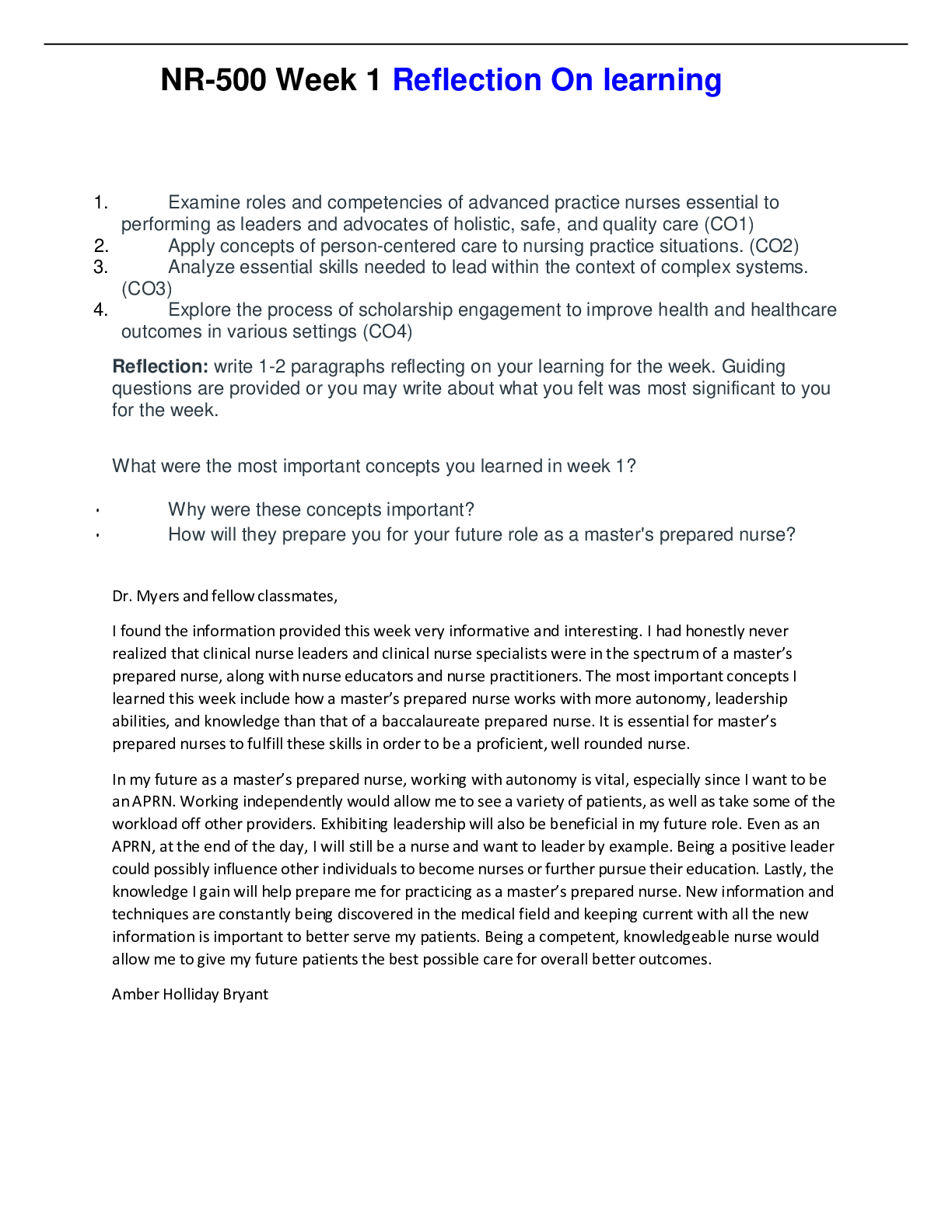


 (1).png)
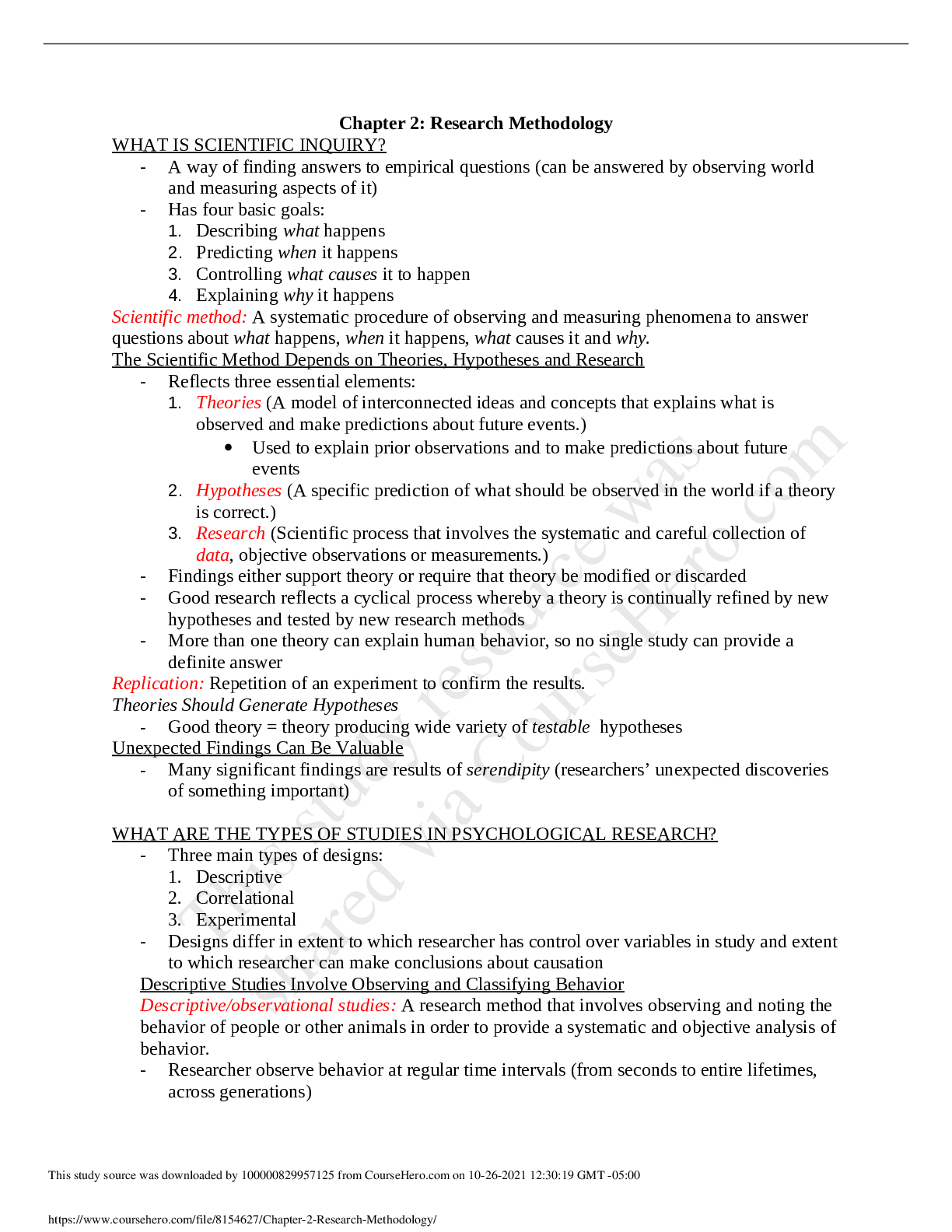
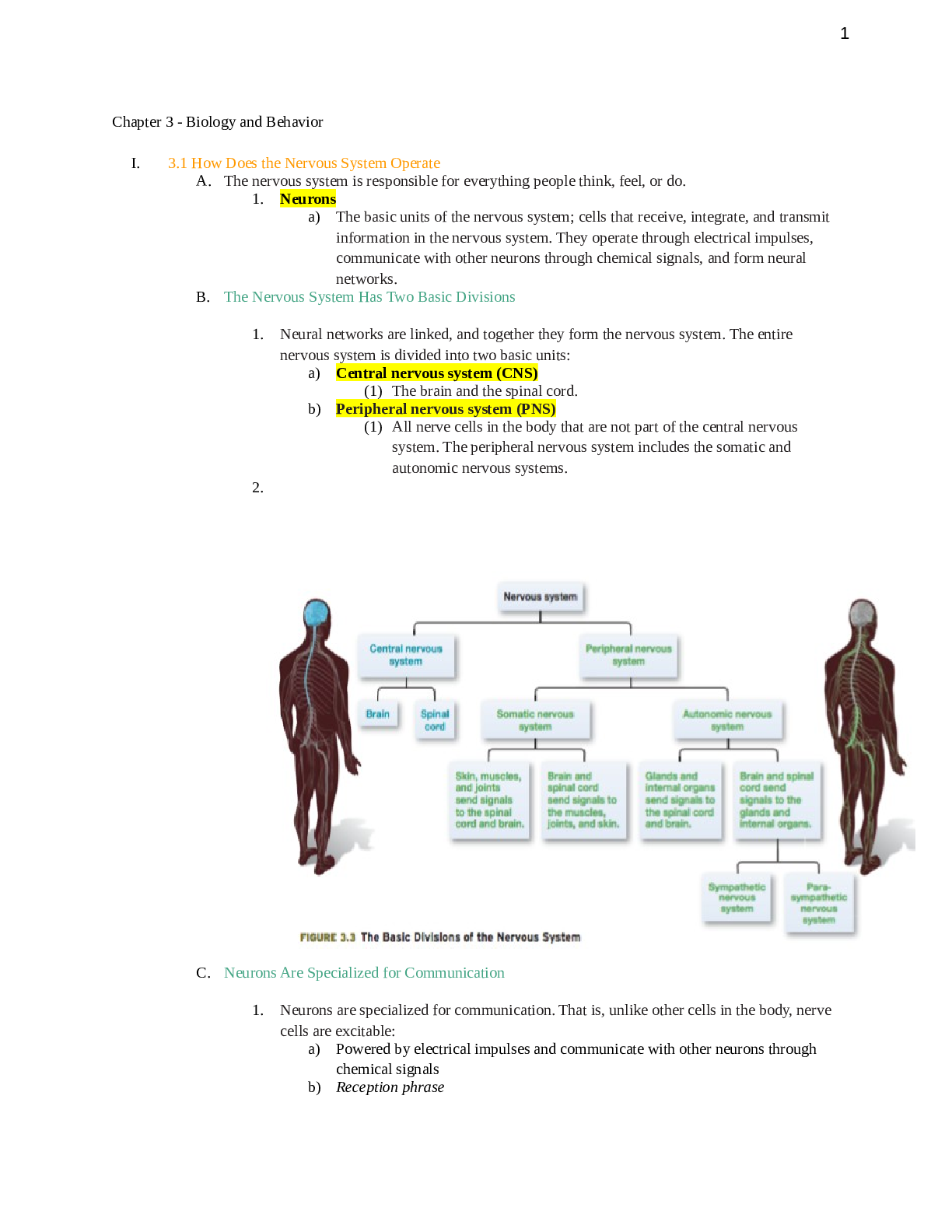
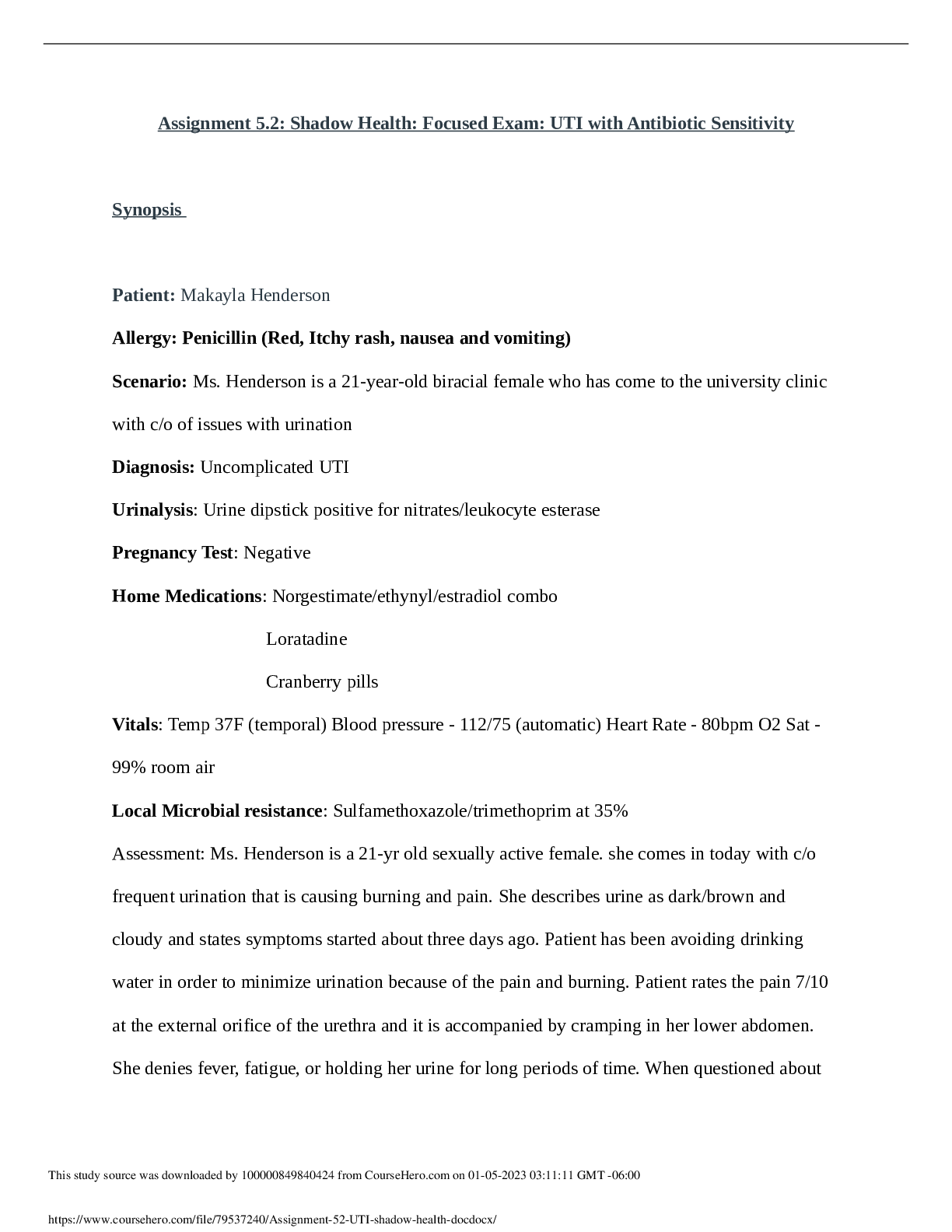
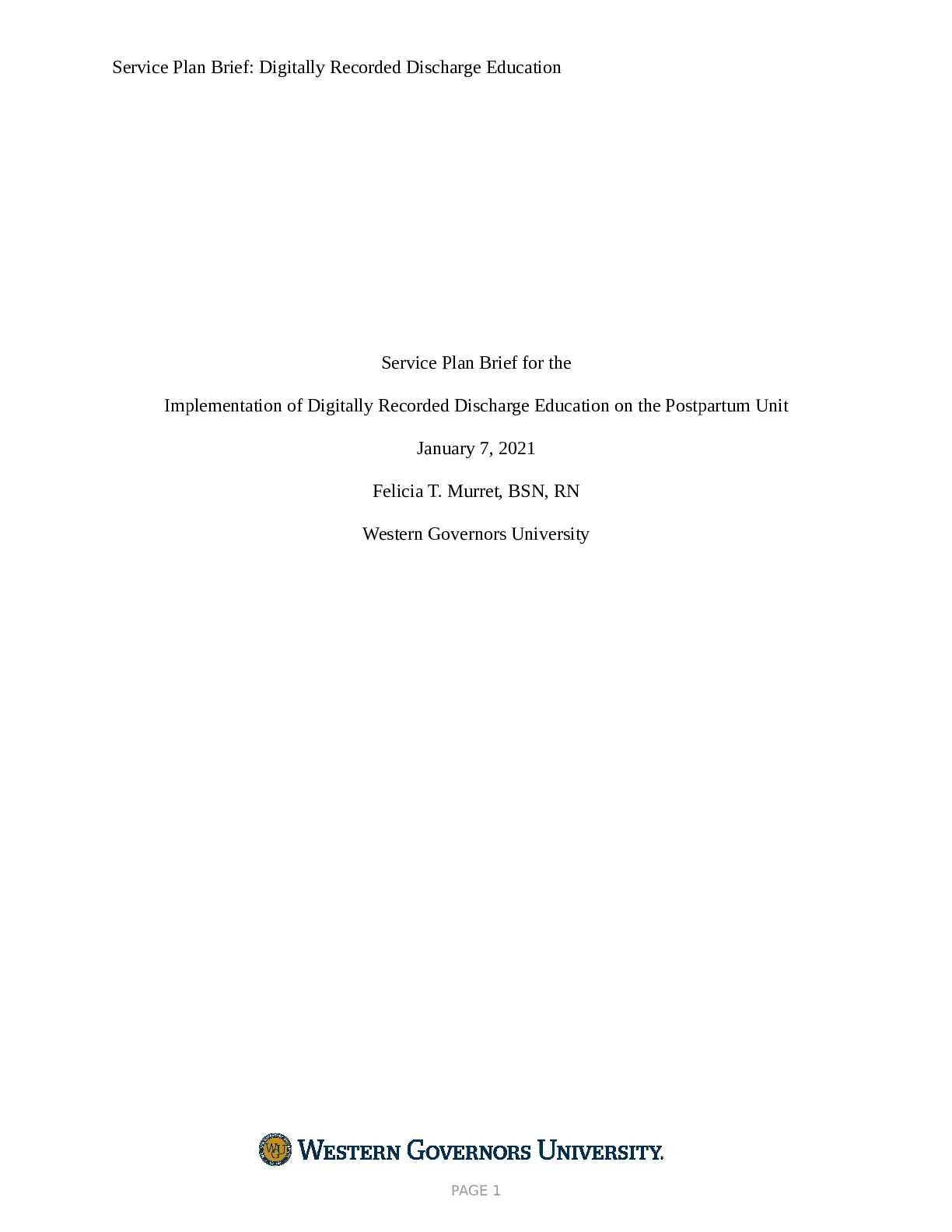
.png)









